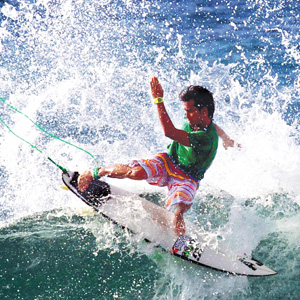Surfing has gained a huge following as a popular sport and recreation in the Philippines these days. Thanks to our local surfers who have been conquering waves and awards in surfing competitions here and abroad. But how safe is surfing?
Luke Landrigan, a 28-year-old Filipino-Australian surfing champion, says he has never encountered any danger while surfing, but he has seen people who have been in danger. He admits, too, that he never received any briefing on the perils of surfing when he started out. “You sort of grow up, and just witness it yourself.” But does he even think about his safety when surfing? “If the waves are big and dangerous, I do. But other than that, it’s all fun,” he answers.
Besides being the national title holder at the 2009 Baler Aurora National Championship and Silver Medalist at the 2008 Asian Beach Games in Bali, Indonesia, Landrigan also owns and runs the Billabong Surf School in Urbiztondo, San Juan, where the instructors have not only been taught by him but are trained by the Philippine National Red Cross (PNRC) for water safety.
If Siargao’s waves are for pros, San Juan beach has the best breaks for beginners. The best time to surf in San Juan is September to February, while summer months have small waves, according to Landrigan. “We make sure to teach surfing only on waves that are safe for first-timers. If the waves are not suitable for beginners, we don’t allow it, kahit anong kulit,” he explains.
Landrigan, who is also a certified lifeguard and surf instructor in Australia, warns that some of the biggest troubles to watch out for in the water are dangerous currents and undertows. He, too, cautions people with back problems against taking up the sport.
But if surfers appear to be on their own out in the water, on dry land, when big events like the annual three-day “La Union Surfing Break” takes place, someone has their back. Arthur S. Cortez, Jr., tourism operations division chief of the Provincial Information & Tourism Office (PITO), says that coordination for this annual event with the regional office of the Philippine National Police (PNP), PNRC, Philippine Coastguard, Municipal Rural Health Unit of San Juan and San Fernando City Health Office resulted in personnel on-site deployment from each agency for 24 hours.
Since the surfing break’s outset in 2006, the tourism office and PNP have estimated crowd attendance of about 6,000 to 9,000 yearly. But with the increasing number of people in attendance, the only troubles in the past events were lost cell phones, fistfights—all due to intoxication, says Cortez who assures that all the troublemakers were apprehended. Adamor L. Dagang, PITO officer, also adds, “The number of attendees is growing each year, but so far, no untoward incidents happened for last year’s event.”
Surfers not only seek out the immensity and seclusion of surfing, but the adrenaline rush, too. But conquering the unknown and living in the moment will all suddenly seem foolish if you aren’t being on your guard. Taking simple precautions, like surfing with a buddy, can save your life, so the waves do not conquer you — you conquer it.






